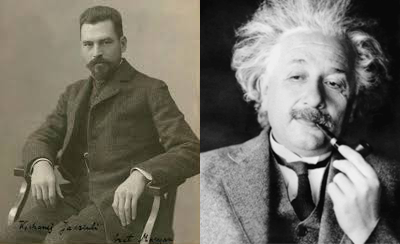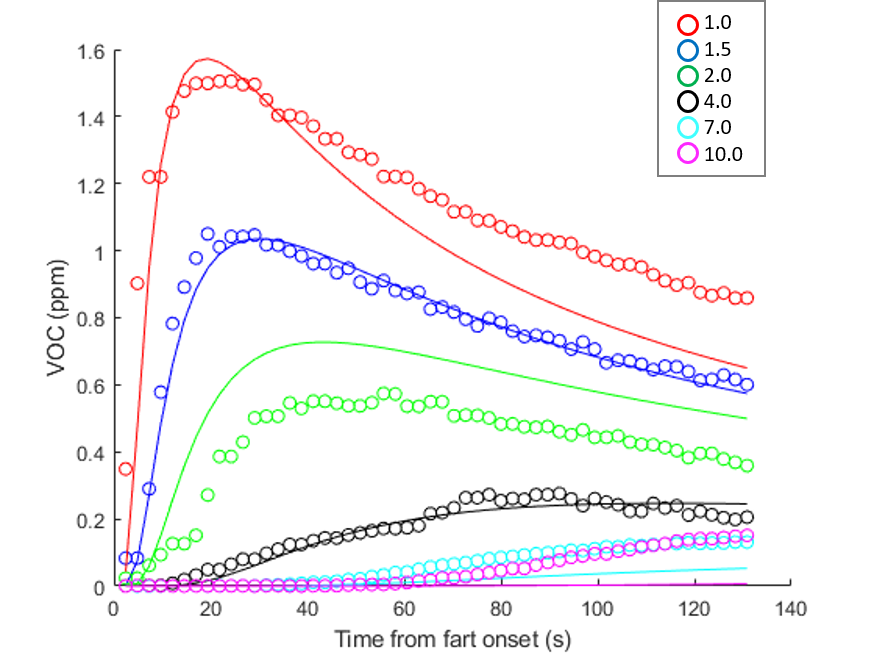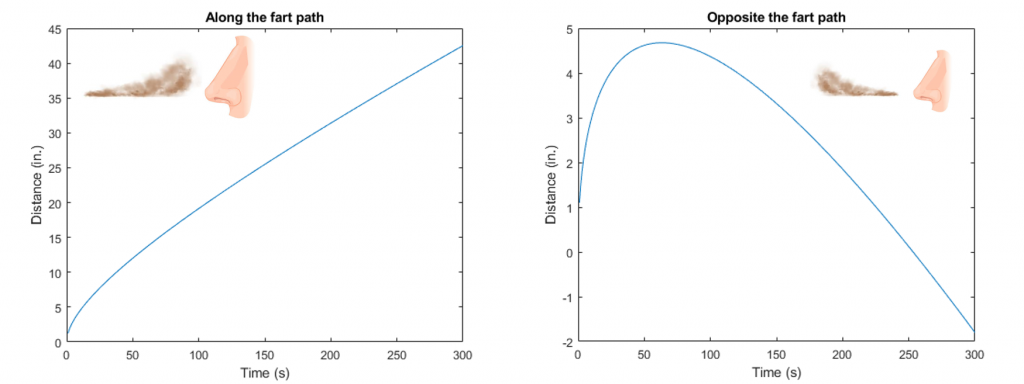Question: How fast do farts travel?
Short answer: About 8 inches per minute.
Long answer: According to random people on the internet, the speed of farts is something like 3 meters per second. We were unable to locate a source for this claim, and it struck us as implausibly fast.
With the advent of high-resolution flatodynamics, we were able to track the dispersal of fart smell in space and time. This would have been impossible in our original experimental setup, which only allowed us to measure air quality at a single point in space, with relatively poor temporal resolution. In the high-resolution experimental rig, we have recorded 340 more farts, bringing the grand total to 1959.
Farts are propelled at some unknown velocity, but once they enter the air the spread of smell is likely governed by the random diffusion of particles through the environment. Both of these concepts can be formalized with variations of the Diffusion equation, which is a general way of capturing the dispersion of particles through a medium like air. The rate of diffusion is determined by various factors, including air pressure and temperature, some of which are already known to have a small effect on the properties of farts.
A handy version of the Diffusion equation was developed independently by Smoluchowski and Einstein.

It describes the concentration of gas particles at different positions in space and time, given a few parameters:

Here C is the gas concentration, M is the original amount of fart particles per unit cross-sectional area, x0 is the position at which the fart originates, D is the diffusivity coefficient, and v is the velocity. Of particular relevance is the parameter D, which captures the rate of diffusion in units of in2/s, and v, which represents a constant drift velocity.
By fitting this equation to the data from individual farts, we can estimate the relevant parameters, which will tell us how fast farts move. Below is an example fart, with the air quality at different depths indicated by the open circles and the model fits by the solid lines.

The quality of the model fit is very good, though not perfect, with the correlation between the data and the model being 0.95. According to the model, this fart originated at 0.88 above the collection tube (x0 = -0.88), where it had a VOC concentration of 43.5 ppm. It then propagated down the tube, and this can be seen in the plot as the increase in VOC concentrations at different depths and times.
Overall, the average R2 value was 0.76; we discarded farts that were not well fit by the model (R2 < 0.75), leaving us with 158 farts. An interesting preliminary observation is that the median value of x0 recovered by the model was –0.67”. This suggests that the model determined that the farts were originating about an inch above the tube, which is surely correct, although we have not attempted a precise measurement.
With the model having passed this test, we can use the other parameters to estimate the speed at which fart smell moves through the air. Even without this detailed analysis, it’s clear in the example above that fart smells move very slowly. The air quality sensor located 10” from the top of the collection tube (shown in pink in the figure) does not register a change in VOC until nearly a minute after the fart has occurred, which means that the claim that fart velocity is 3 meters/second is likely off by several orders of magnitude.
In fact, analysis of the parameters recovered by the model indicate two facts. First the drift velocity v is has an average value of 0.053 in./sec (3.2 in./min.). The actual propulsion is probably much higher, but for the moment we only have access to outputs that have passed through one or two layers of clothing.
The other driver of the spread of smell is diffusion, with the average diffusivity coefficient D being 0.17 in2/second. Based on these two facts, we can then calculate that the average fart diffuses according to the following space-time relationships:

The plot on the left shows the progression of fart smell toward someone who is standing in the path of the fart, from the time it was emitted. Anyone within about 4 ft. of the fart will experience the effects within about 5 minutes. In contrast, as shown on the right, someone positioned opposite the fart path (i.e. in front of the farter), they will notice a slight change in air quality that dissipates after about 4 minutes.
Considering only the trajectory on the left, we therefore arrive at an answer to the original question: The speed of an average fart is about 8 inches per minute. This is about twice as fast as a sloth can walk, but slow enough that one can easily outrun them.
Of course, in our controlled experiments the farts were trapped in a tube, whereas in a natural setting they would be acted upon by air circulating in the environment. Air flow is therefore likely to be the primary determinant of the spread of farts. Farts are slow on their own, but if you really want to avoid the stink, the best strategy is avoid being downwind.
